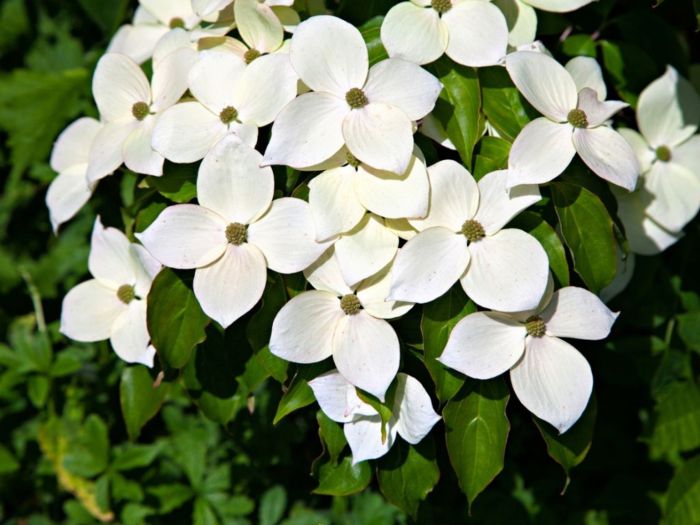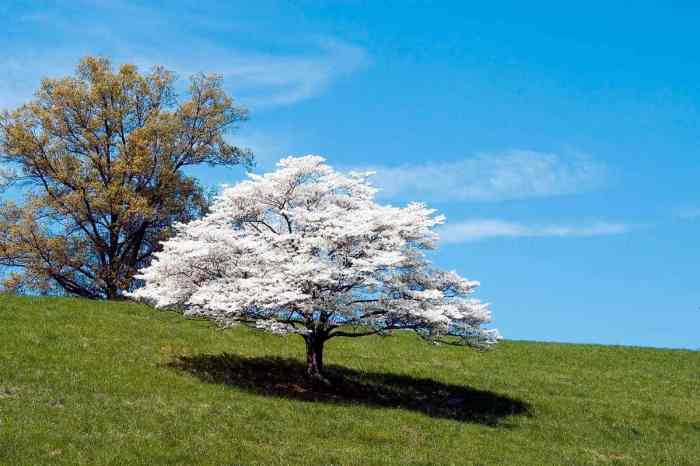Soil Conditions and Preparation: When To Plant Dogwood Tree

When to plant dogwood tree – Planting a dogwood tree successfully hinges on providing it with the right soil conditions. Dogwoods thrive in well-drained, slightly acidic soil, and preparing the planting site appropriately is crucial for their long-term health and vigor. Understanding the ideal soil composition and taking steps to amend unsuitable soil are key to ensuring your dogwood flourishes.Dogwoods prefer a soil pH ranging from 5.0 to 6.5.
Soils outside this range can hinder nutrient uptake, leading to stunted growth and potential health problems. Good drainage is equally important; soggy soil can lead to root rot, a fatal condition for dogwoods. The ideal soil texture is a loam—a balanced mix of sand, silt, and clay—which provides excellent drainage while retaining enough moisture.
Ideal Soil Composition and Drainage, When to plant dogwood tree
Dogwoods need soil that’s well-drained to prevent root rot. Clay soils tend to retain too much water, while sandy soils drain too quickly, leading to inconsistent moisture levels. The best soil is a loam, offering a balance of drainage and moisture retention. Proper drainage is easily checked by digging a hole and filling it with water; if the water drains away within a few hours, the drainage is adequate.
If it remains for much longer, drainage improvement is necessary. A soil test can provide a precise measurement of pH and nutrient levels, guiding soil amendment strategies.
Preparing the Planting Site
Before planting, prepare the planting site by removing weeds and other vegetation within a radius of several feet around the intended planting location. This reduces competition for nutrients and water. Next, loosen the soil to a depth of at least 12 inches, improving aeration and root penetration. Incorporate organic matter, such as compost or well-rotted manure, to enhance soil structure, drainage, and nutrient content.
The best time to plant a dogwood tree is in early spring or fall, after the hottest part of summer has passed. If you’re also looking for a beautiful flowering tree to add to your landscape, consider the stunning visual impact of a plant cherry blossom tree ; its vibrant blooms complement the dogwood’s delicate flowers.
Remember to choose a planting location with proper sunlight and drainage for both your dogwood and cherry blossom trees for optimal growth.
This step is particularly important for heavy clay or sandy soils. A layer of mulch around the base of the tree after planting helps retain moisture and suppress weeds.
Amending Heavy Clay Soil and Sandy Soil
Heavy clay soils and sandy soils require different amendment strategies to create a suitable environment for dogwoods.
- Amending Heavy Clay Soil: Heavy clay soil needs improvement in drainage and aeration.
- Work in generous amounts of organic matter, such as compost, peat moss, or well-rotted manure, to improve soil structure and drainage. This helps break up the dense clay particles.
- Incorporate coarse materials like perlite or vermiculite to enhance drainage further. These materials increase porosity and allow for better water penetration.
- Avoid overwatering, as this can exacerbate drainage problems in clay soil.
- Amending Sandy Soil: Sandy soil needs to retain more moisture.
- Amend sandy soil with organic matter like compost or leaf mold to increase its water-holding capacity. Organic matter helps to bind the sand particles together, creating a more stable soil structure.
- Consider adding a soil conditioner, such as peat moss, to further enhance water retention.
- Mulch generously to reduce evaporation and maintain consistent soil moisture.
Choosing and Planting a Dogwood Tree

Selecting and planting your dogwood tree properly sets the stage for years of beautiful blooms and healthy growth. Careful consideration of the sapling’s health and a precise planting technique will maximize its chances of thriving in your garden.Choosing a healthy dogwood sapling or container-grown tree involves examining both the root system and the overall appearance. A vigorous root system is crucial for establishment.
Selecting a Healthy Dogwood Tree
Inspect the root system for healthy, light-colored roots. Avoid trees with circling roots, which indicate they were grown in a container that was too small and may struggle to establish themselves. The roots should be firm and moist, not dry or brittle. A healthy tree will also have a well-formed central leader, a strong main stem, and evenly spaced branches.
Look for a tree free from pests, diseases (such as leaf spots or cankers), or physical damage. The bark should be smooth and unbroken, appropriate for the species and age of the tree. The leaves (if present) should be a vibrant, healthy green, showing no signs of discoloration or wilting.
Planting Your Dogwood Tree
Dig a hole twice as wide as the root ball, but only as deep. Imagine a root ball about the size of a large basketball; the hole would be about twice that diameter, roughly the size of a small child’s wading pool. This wider hole allows the roots to spread easily, preventing circling and promoting vigorous growth. Gently loosen the soil at the bottom of the hole to encourage root penetration.Carefully remove the dogwood from its container, being mindful not to damage the root ball.
If the roots are circling, gently tease them apart to encourage outward growth. Place the tree in the hole, ensuring the top of the root ball is level with the surrounding ground. Avoid planting too deeply; the root flare (where the trunk widens at the base) should be visible above the soil line.Backfill the hole with the soil you removed, ensuring there are no large air pockets.
Gently firm the soil around the root ball to eliminate air pockets and provide good root contact. Water thoroughly after planting to settle the soil and help the roots establish contact with the surrounding earth. Imagine a slow, gentle soaking that gradually saturates the soil around the root ball.
Planting Depth and Spacing
The ideal planting depth is crucial. Planting too deep can suffocate the roots, while planting too shallow can leave the tree unstable and susceptible to drought. The root flare, the slightly wider part of the trunk at the base, should be visible above the ground. This allows for proper aeration and prevents root rot.When planting multiple dogwood trees, spacing depends on the mature size of the chosen cultivar.
For example, a smaller variety might only need 8-10 feet between trees, whereas a larger variety may require 15-20 feet. Imagine a mature dogwood with a 15-foot spread; to allow for adequate growth and prevent overcrowding, you would need a similar distance between each tree. This allows for sufficient sunlight, water, and nutrients for each tree to reach its full potential.
FAQ Explained
What type of dogwood is best for Medan’s climate?
Research dogwood varieties suited to Medan’s specific climate zone and soil conditions. Local nurseries can offer excellent advice.
How often should I water a newly planted dogwood tree?
Water deeply and regularly, especially during dry spells, but avoid overwatering. Check soil moisture before watering.
Can I plant a dogwood tree near other plants?
Give your dogwood tree enough space to grow without competition from other plants. Avoid overcrowding.
What are the signs of a dogwood tree disease?
Look for leaf spots, wilting, or unusual growths. Consult a gardening expert or local nursery if you suspect disease.
